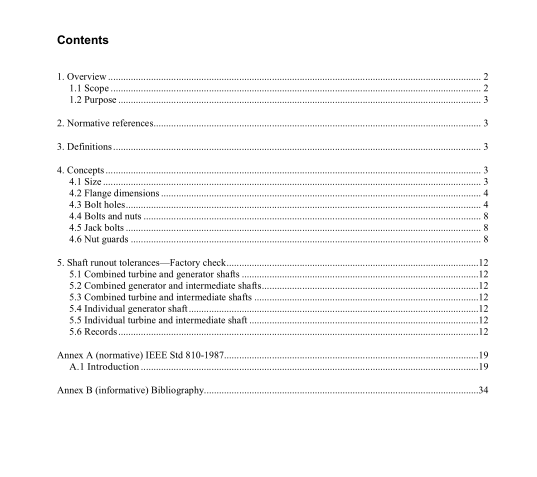IEEE 810-2015 pdf download.IEEE Standard for Hydraulic Turbine and Generator Shaft Couplings and Shaft Runout Tolerances
3. Definitions
The IEEE Standards Dictionary: Glossary of Terms & Definitions should be referenced for terms in this standard.
4 4. Concepts
4.1 Size The shaft diameters included in this standard range from 90 mm to 2000 mm. Most shafts that have integrally forged couplings are of special design rather than a stock product, and the greatest possible selection of sizes is required. For this reason, instead of following a series of preferred numbers, these standard shaft diameters are increased by 10 mm to 15 mm intervals, up to 230 mm; by 20 mm to 30 mm intervals, from 230 mm to 600 mm; and by 40 mm to 50 mm intervals, from 600 mm to 2000 mm. Large forgings are difficult to procure and shaft diameters larger than 2000 mm are usually fabricated. Also, in these sizes, shaft stiffness and torque requirements are achieved at lower cost with fabricated rather than forged shafts.
4.2 Flange dimensions
In determining the proportions of the couplings included in this standard, the diameter of the flange, in each case, has been kept as small as possible without reducing the strength of the coupling below that of the shaft in either torsion or bending. Two values of flange thickness are provided: one for shafts that may be subject to bending at the coupling; and another for shafts not subject to bending at the coupling. However in the latter case, if the hydraulic thrust is unusually great, the same value of flange thickness between C and D should be used and coupling bolts of higher tensile strength steel may be found necessary.
The flange dimensions, Table 1, are based upon the following approximate proportions:
Flange Thickness (C) = 0.25 × Shaft Diameter (A)
Flange Thickness (D) = 0.20 × Shaft Diameter (A)
Rabbet Diameter (E) = 0.60 × Shaft Diameter (A)
Relief Diameter (I) = Shaft Diameter (A)
For matching shafts of different diameters, either the dimensions of the larger coupling shall be used for both halves, or the larger shaft shall be necked-down near the coupling to the diameter of the smaller shaft, and the dimensions of the smaller coupling shall be adopted for both. For all vertical and horizontal shaft installations, the turbine shaft shall be provided with the male half coupling.
4.3 Bolt holes
Shafts 300 mm and larger in diameter shall have the bolt holes counterbored from the back of the flange to facilitate bolt placement. The depth of this counterbore shall be such that the length (in each flange) of the reamed portion S, Table 2, of the bolt hole is at least 0.8 times the nominal body diameter of the bolt.
4.4 Bolts and nuts The number and diameter of the bolts are based upon the assumption that the torque is transmitted only by shear in the bolts and that the combined stress in the bolts may safely be as much as 30% greater than the combined stress in the shaft. The diameter of the bolt body shall be determined from information given in Table 2.
NOTE—Hexagon head, round head, or stud bolts with nuts at both ends, may be used for all bolt diameters up to and including 130 mm at the discretion of the manufacturer. For bolts above 130 mm in diameter, the use of stud bolts with round nuts is recommended. The dimensions listed in Table 1 and Table 2 of this standard for shaft diameters of 1050 mm and larger were based on this recommendation. For shaft diameters up to and including 230 mm, hexagon nuts were used to determine flange diameter. Heavy hexagon nuts were used for all other shaft sizes up to and including 1000 mm.
5 The hexagon bolt heads (if used) shall correspond to the dimensions given in ISO 4014. Bolt heads shall be of the same size as the nuts, or of the size corresponding to the body diameter of the bolts. In the latter case, one flat of the hex head shall be placed parallel to the periphery of the flange to provide clearance for the nut guard.
The nuts shall correspond to the dimensions given in ISO 4032, and shall be of the sizes shown in Table 2 of this standard.
Bolt heads and nuts beyond the sizes listed in ISO 4014 and ISO 4032 shall be dimensioned in accordance with the formulas given in ISO 724. When used, round nuts or bolt heads shall have a diameter equal to or greater than the across-flat dimensions given in those standards. The bolts shall be straight (not tapered) and shall be fitted individually within the clearances specified in Table 2.
The bolts and bolt holes shall be identified with corresponding numbers to facilitate assembly. The length of the bolts shall be such that they will project slightly beyond the nuts.
The diameter of this projecting portion, which is provided for driving when the bolts are being assembled or removed, shall be smaller than the root diameter of the thread. The thread pitch shall be as given in Table 2. Different solutions for transferring the torque from coupling to coupling may be used according to the manufacturer design and calculation. Those solutions could include one or more of the following methods: friction, shear sleeve, dowel pin, or others.
4.5 Jack bolts The jack bolts shall be furnished with the female half coupling for both vertical and horizontal shafts.
The diameter and thread pitch shall be as indicated in Table 2. The length shall suit the thickness of the coupling.
4.6 Nut guards In order to permit the installation of nut guards of the same outside diameter as the flange (Table 1, Dimension B), a clearance Q has been provided between the edge of the flange and the nuts.
NOTE—The nut guard may also be allowed to overlap the flange.IEEE 810 pdf download.IEEE 810 pdf download
IEEE 810-2015 pdf download

Leave a Reply